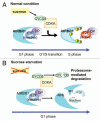Both negative and positive G1 cell cycle regulators undergo proteasome-dependent degradation during sucrose starvation in Arabidopsis
- PMID: 22019639
- PMCID: PMC3258074
- DOI: 10.4161/psb.6.9.16877
Both negative and positive G1 cell cycle regulators undergo proteasome-dependent degradation during sucrose starvation in Arabidopsis
Abstract
The proteasome pathway regulates many aspects of biological processes in plants, such as plant hormone signaling, light responses, the circadian clock and regulation of cell division. Key cell-cycle regulatory proteins including B-type cyclins, Cdc6, cyclin-dependent kinase inhibitors and E2Fc undergo proteasome-dependent degradation. We used the proteasome inhibitor MG132 to show that proteolysis of Arabidopsis RETINOBLASTOMA-RELATED 1 (AtRBR1) and three E2Fs is mediated by the proteasome pathway during sucrose starvation in Arabidopsis suspension MM2d cells. We found previously that estrogen-inducible RNAi-mediated downregulation of AtRBR1 leads to a higher frequency of arrest in G2 phase, instead of G1-phase arrest in the uninduced control, after sucrose starvation. Degradation of not only negative (AtRBR1 and E2Fc) but also positive (E2Fa and E2Fb) cell cycle regulators after sucrose starvation may be required for arrest in G1 phase, when cells integrate a variety of nutritional, hormonal and developmental signals to decide whether or not to commit to entry into the cell cycle.
Figures

Comment on
-
Arabidopsis G1 cell cycle proteins undergo proteasome-dependent degradation during sucrose starvation.Plant Physiol Biochem. 2011 Jun;49(6):687-91. doi: 10.1016/j.plaphy.2011.03.001. Epub 2011 Mar 21. Plant Physiol Biochem. 2011. PMID: 21444209
Similar articles
-
Arabidopsis G1 cell cycle proteins undergo proteasome-dependent degradation during sucrose starvation.Plant Physiol Biochem. 2011 Jun;49(6):687-91. doi: 10.1016/j.plaphy.2011.03.001. Epub 2011 Mar 21. Plant Physiol Biochem. 2011. PMID: 21444209
-
Arabidopsis RETINOBLASTOMA-RELATED PROTEIN 1 is involved in G1 phase cell cycle arrest caused by sucrose starvation.Plant Mol Biol. 2008 Feb;66(3):259-75. doi: 10.1007/s11103-007-9268-2. Epub 2007 Dec 7. Plant Mol Biol. 2008. PMID: 18064404
-
Dissecting regulatory pathways of G1/S control in Arabidopsis: common and distinct targets of CYCD3;1, E2Fa and E2Fc.Plant Mol Biol. 2009 Nov;71(4-5):345-65. doi: 10.1007/s11103-009-9527-5. Epub 2009 Aug 7. Plant Mol Biol. 2009. PMID: 19662336
-
Proteasome regulation, plant growth and stress tolerance.Plant Signal Behav. 2009 Oct;4(10):924-7. doi: 10.4161/psb.4.10.9469. Epub 2009 Oct 29. Plant Signal Behav. 2009. PMID: 19826220 Free PMC article. Review.
-
Regulation of the retinoblastoma-E2F pathway by the ubiquitin-proteasome system.Biochim Biophys Acta. 2015 Oct;1849(10):1289-97. doi: 10.1016/j.bbagrm.2015.08.008. Epub 2015 Aug 28. Biochim Biophys Acta. 2015. PMID: 26319102 Review.
Cited by
-
Serine Hydroxymethyltransferase 1 Is Essential for Primary-Root Growth at Low-Sucrose Conditions.Int J Mol Sci. 2022 Apr 20;23(9):4540. doi: 10.3390/ijms23094540. Int J Mol Sci. 2022. PMID: 35562931 Free PMC article.
-
S6K1 and E2FB are in mutually antagonistic regulatory links controlling cell growth and proliferation in Arabidopsis.Plant Signal Behav. 2013 Jun;8(6):e24367. doi: 10.4161/psb.24367. Epub 2013 Mar 26. Plant Signal Behav. 2013. PMID: 23531690 Free PMC article.
References
-
- Gutierrez C. Coupling cell proliferation and development in plants. Nat Cell Biol. 2005;7:535–541. - PubMed
-
- Gupta AK, Kaur N. Sugar signaling and gene expression in relation to carbohydrate metabolism under abiotic stresses in plants. J Biosci. 2005;30:761–776. - PubMed
-
- Pines J. Four-dimensional control of the cell cycle. Nat Cell Biol. 1999;1:73–79. - PubMed
-
- Joubes J, Chevalier C, Dudits D, Heberle-Bors E, Inze D, Umeda M, Renaudi JP. CDK-related protein kinases in plants. Plant Mol Biol. 2000;43:607–620. - PubMed
-
- Inze D, De Veylder L. Cell cycle regulation in plant development. Ann Rev Genet. 2006;40:77–105. - PubMed
MeSH terms
Substances
LinkOut - more resources
Full Text Sources
Molecular Biology Databases
